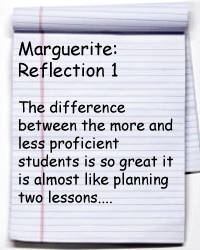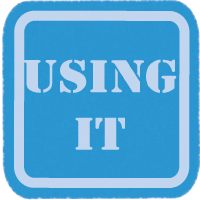
 Differentiating for Student Needs
Differentiating for Student Needs

It is often the case in a language classroom that there will be students at various levels of language proficiency. Whether due to previous experience or individual differences these students may all have different language levels and therefore different needs. In the case studies we see that our teacher friends express some anxieties about differentiating lessons for different levels of learners. Marguerite, for instance, is having some troubles planning for both the more and less proficient students in her class. What types of things could she do to engage ALL of the learners? In this section we will explore this question and others in addition to taking a look at some strategies for differentiating for student needs in the language classroom. |
What is differentiated instruction?
Differentiated instruction is an approach to planning so that one lesson is taught to the entire class while meeting the individual needs of each child.
Verna Eaton, a Special Education Teacher from Saskatchewan points out the characteristics of a differentiated lesson. A differentiated lesson:
- has a definite aim for all students
- includes a variety of teacher techniques aimed at reaching students at all levels
- considers student learning styles in presenting lessons
- involves all students in the lesson through the use of questioning aimed at different levels of thinking (Bloom's Taxonomy)
- allows that some students will require adjusted expectations
- provides choice in the method students will use to demonstrate their learning
- involves understanding the concepts
- accepts that different methods are of equal value
- evaluates students based on their individual characteristics and language level
For more information from Verna Eaton visit her web site on Differentiated Instruction: http://www.ualberta.ca/~jpdasddc/incl/difinst.htm
Where does differentiation fit into B-SLIM?
Differentiation can be incorporated at almost every stage of B-SLIM. Let's take a look at some examples:
What are some strategies for differentiating in the SL/FL classroom?
 |
Watch the videos below to see how these language teachers incorporate differentiation in their classroom. |
time 3:16 |
time 1:03 |
As we saw with the previous question, it is often the case that many of the strategies that can be used to differentiate instruction are also strategies that are used to promote language learning. In this way, one could say that differentiation is an embedded result of effective language instruction. However, there are some specific strategies that can be considered when planning a lesson to meet the individual needs of each learner.
Strategies |
Application for the Language Classroom |
Gauge student readiness at ALL stages |
Collect feedback throughout all stages of the learning process including assessment of conversations, products & observation (Triangulation). |
Use Flexible Groupings |
As student performance will vary it is important to permit movement between groups. Incorporate pair and group work (especially during Getting it and Using it stages of B-SLIM) to encourage student interaction |
Discover and appeal to different Learning Profiles/Styles/Intelligences |
Consider Gardner’s Multiple Intelligences and different Learning Styles when planning. |
Appeal to student Interest |
Talk with students to discover their interests and try to incorporate these interests when planning. |
Apply Bloom’s Taxonomy to questioning and activities |
Consider Bloom’s Taxonomy when planning in order to plan questions and activities that are at an appropriate level for each student. |
back to top
 |
Test your knowledge of Differentiation with this quiz. |












